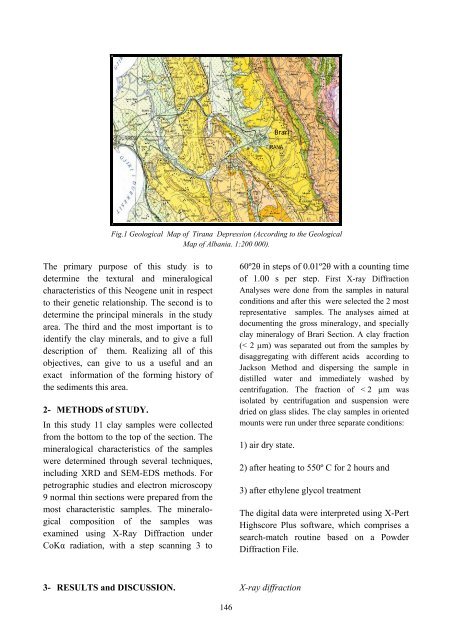DYNAMICS and ACTIVE PROCESSES - International Lithosphere ...
DYNAMICS and ACTIVE PROCESSES - International Lithosphere ...
DYNAMICS and ACTIVE PROCESSES - International Lithosphere ...
You also want an ePaper? Increase the reach of your titles
YUMPU automatically turns print PDFs into web optimized ePapers that Google loves.
The primary purpose of this study is to<br />
determine the textural <strong>and</strong> mineralogical<br />
characteristics of this Neogene unit in respect<br />
to their genetic relationship. The second is to<br />
determine the principal minerals in the study<br />
area. The third <strong>and</strong> the most important is to<br />
identify the clay minerals, <strong>and</strong> to give a full<br />
description of them. Realizing all of this<br />
objectives, can give to us a useful <strong>and</strong> an<br />
exact information of the forming history of<br />
the sediments this area.<br />
2- METHODS of STUDY.<br />
Fig.1 Geological Map of Tirana Depression (According to the Geological<br />
Map of Albania. 1:200 000).<br />
In this study 11 clay samples were collected<br />
from the bottom to the top of the section. The<br />
mineralogical characteristics of the samples<br />
were determined through several techniques,<br />
including XRD <strong>and</strong> SEM-EDS methods. For<br />
petrographic studies <strong>and</strong> electron microscopy<br />
9 normal thin sections were prepared from the<br />
most characteristic samples. The mineralogical<br />
composition of the samples was<br />
examined using X-Ray Diffraction under<br />
CoK� radiation, with a step scanning 3 to<br />
60º2� in steps of 0.01º2� with a counting time<br />
of 1.00 s per step. First X-ray Diffraction<br />
Analyses were done from the samples in natural<br />
conditions <strong>and</strong> after this were selected the 2 most<br />
representative samples. The analyses aimed at<br />
documenting the gross mineralogy, <strong>and</strong> specially<br />
clay mineralogy of Brari Section. A clay fraction<br />
(< 2 µm) was separated out from the samples by<br />
disaggregating with different acids according to<br />
Jackson Method <strong>and</strong> dispersing the sample in<br />
distilled water <strong>and</strong> immediately washed by<br />
centrifugation. The fraction of < 2 µm was<br />
isolated by centrifugation <strong>and</strong> suspension were<br />
dried on glass slides. The clay samples in oriented<br />
mounts were run under three separate conditions:<br />
1) air dry state.<br />
2) after heating to 550º C for 2 hours <strong>and</strong><br />
3) after ethylene glycol treatment<br />
3- RESULTS <strong>and</strong> DISCUSSION. X-ray diffraction<br />
146<br />
Brari<br />
The digital data were interpreted using X-Pert<br />
Highscore Plus software, which comprises a<br />
search-match routine based on a Powder<br />
Diffraction File.




